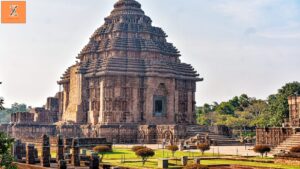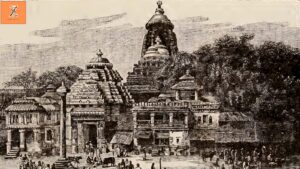Best 4 days Itinerary for Odisha Golden Triangle in 2025: Complete Guide

Odisha is a state rich in history, culture, and beautiful architecture. The capital city, Bhubaneswar, is home to numerous Hindu and Jain monuments, offering a blend of spiritual and architectural wonders. This city also boasts delicious cuisine and attractive tourist spots. Another major destination in Odisha is Puri, a city famous for the iconic Jagannath Puri Temple, one of the four significant pilgrimage sites dedicated to Lord Vishnu.
In this comprehensive travel guide, we will cover the highlights of three major cities in Odisha: Bhubaneswar, Puri, and the UNESCO World Heritage Site, Konark. These cities form the Golden Triangle of Odisha, a must-visit for most tourists. The guide will include sections on history, geography, the best time to visit, top attractions, transportation, accommodations, and a detailed itinerary. We’ll conclude with an expense sheet for planning your trip. Let’s dive in.
About the Golden Triangle of Odisha

The Golden Triangle consists of Bhubaneswar, Puri, and Konark. Bhubaneswar serves as the starting point, and from there, Puri is about 65 km away, while Konark is 40 km to the east of Puri. To explore these cities effectively, begin in Bhubaneswar and use buses, taxis, or rented vehicles to visit the remaining destinations.
History and Geography

Bhubaneswar: Bhubaneswar, the capital of Odisha, derives its name from the Sanskrit word “Tribhubaneswar,” meaning Lord Shiva. Located in eastern India and south of the Mahanadi River, Bhubaneswar is known as the Temple City of India. Historically, it was part of the Chedi Kingdom and later ruled by the Kalinga Empire and the Mughals. The city’s rich heritage includes around 600 temples built in the Kalinga architectural style, though it is said to have once housed over 7,000 temples.

Puri: Puri is one of India’s most important spiritual destinations, connected to the Bay of Bengal. Its history dates back to the 12th century, when the Jagannath Puri Temple was constructed. This temple attracts millions of devotees, especially during the Rath Yatra festival. Puri’s golden beach and vibrant cultural atmosphere also draw numerous tourists.

Konark: The name Konark comes from two Sanskrit words: “Kona” (corner) and “Ark” (sun), reflecting its location and dedication to the Sun God. The Konark Sun Temple, built in the 13th century by King Narasimha Deva of the Eastern Ganga Dynasty, is a masterpiece of Kalinga architecture. This UNESCO World Heritage Site is renowned for its intricate carvings and alignment with sunrise.
Best Time to Visit
The best time to visit the Golden Triangle is during the winter months from November to March, when the weather is pleasant. Summers (March to June) can be scorching, and the monsoon season (July to September) brings heavy rains, making travel less convenient. However, if you enjoy the rainy season, the monsoon can offer a unique charm.
Top Places to Visit
Bhubaneswar

- Udayagiri and Khandagiri Caves: The Udayagiri and Khandagiri Caves are a pair of ancient Jain cave complexes near Bhubaneswar. Known for their intricate carvings and historical significance, Udayagiri boasts 18 caves, while Khandagiri has 15. Cave No. 3, known as the Rani Gumpha or Queen’s Cave, is especially renowned for its artistic excellence and detailed inscriptions.
- Dhauli Shanti Stupa: The Dhauli Shanti Stupa, located on the serene Dhauli hills, is a symbol of peace and harmony. Built in the 1970s, this Buddhist structure commemorates the transformation of Emperor Ashoka after the Kalinga War. The stupa’s white dome and golden spires are a stunning sight, offering a peaceful atmosphere and panoramic views.
- Lingaraj Temple: The Lingaraj Temple is a magnificent 11th-century structure dedicated to Lord Harihara, a union of Lord Vishnu and Lord Shiva. This architectural masterpiece exemplifies the Kalinga style with its intricately carved stone walls and towering spire. It remains an important spiritual center and a must-visit in Bhubaneswar.
- Regional Museum of Natural History: The Regional Museum of Natural History in Bhubaneswar provides an educational and engaging experience with exhibits on the region’s biodiversity. Featuring displays of preserved specimens, fossils, and ecological dioramas, the museum is perfect for nature enthusiasts and students.
- Chausath Yogini Temple: The Chausath Yogini Temple, near Bhubaneswar, is one of the rare temples dedicated to the 64 incarnations of Goddess Durga. Its circular structure and open-air design make it a unique architectural wonder. The temple is steeped in history and offers a serene atmosphere for meditation and exploration.
- Parsuramesvara Temple: The Parsuramesvara Temple, a 7th-century shrine, is one of the oldest surviving temples in Odisha. Dedicated to Lord Shiva, the temple is adorned with intricate carvings depicting Shiva Tandav dance forms and other mythological themes, showcasing the artistic brilliance of ancient times.
- Nandankanan Zoological Park: The Nandankanan Zoological Park is a sprawling wildlife sanctuary located near Bhubaneswar. Famous for its unique white tigers, the park also features a ropeway connecting it to a botanical garden. Visitors can enjoy crocodile feeding, nature trails, and the chance to observe diverse wildlife up close.
- Netaji Birthplace Museum: The Netaji Birthplace Museum in Cuttack is a tribute to Subhas Chandra Bose, one of India’s greatest freedom fighters. The museum houses artifacts, photographs, and documents that showcase his life and legacy. It’s a must-visit for history buffs and anyone inspired by India’s struggle for independence.
Puri

- Jagannath Puri Temple: The Jagannath Puri Temple, dedicated to Lord Jagannath, is one of the four sacred Char Dham pilgrimage sites in India. Known for its spiritual significance, the temple also features the world’s largest kitchen, where thousands of devotees are served Mahaprasad daily. The intricate carvings and towering spires make it a symbol of Odisha’s architectural heritage.
- Golden Beach: The Golden Beach in Puri is a vibrant and energetic spot, perfect for unwinding by the Bay of Bengal. Famous for its lively atmosphere, the beach offers food stalls, water sports, and mesmerizing sand sculptures by talented artists. It’s an ideal place to enjoy sunsets and spend quality time with family and friends.
- Narendra Pokhari: The Narendra Pokhari, the largest artificial pond in Odisha, is a peaceful retreat just a short distance from Jagannath Temple. Surrounded by lush greenery, visitors can feed fish and enjoy moments of calm by the serene waters. The pond holds cultural significance and is an integral part of temple rituals.
- Sudarshan Crafts Museum: The Sudarshan Crafts Museum in Puri is a hub for art and culture enthusiasts. Established by a renowned sculptor, it showcases exquisite handcrafted artifacts and provides a space for live crafting demonstrations. The Japanese-style temple within the museum adds to its unique charm and artistic appeal.
- Bedi Hanuman Temple: The Bedi Hanuman Temple, also known as the Dariya Hanuman Temple, is dedicated to Lord Hanuman, who is believed to protect Puri and its temples. Legend has it that Lord Hanuman is bound here to ensure his presence as the city’s guardian. The temple exudes spiritual energy and is an important pilgrimage site.
- Chilika Lake: The vast Chilika Lake, India’s largest brackish water lagoon, is a haven for nature lovers and birdwatchers. A popular spot for boating, the lake is home to numerous migratory birds, including flamingos and herons, especially during winter. Its tranquil waters and picturesque surroundings make it a must-visit destination near Puri.
Sun Temple, Konark

The Sun Temple at Konark, also known as the Konark Sun Temple, is a UNESCO World Heritage Site and a masterpiece of Kalinga architecture. Built in the 13th century by King Narasimhadeva I of the Eastern Ganga dynasty, the temple is dedicated to the Sun God, Surya. It is designed in the shape of a colossal chariot with 12 intricately carved wheels, drawn by seven horses, symbolizing the Sun’s eternal journey across the sky.
The temple is renowned for its elaborate stone carvings depicting scenes from daily life, celestial beings, and mythical creatures. The intricate artwork also reflects the advanced craftsmanship and aesthetic sensibilities of ancient Odisha. Though parts of the temple have been damaged over time, its grandeur remains unparalleled.
An architectural marvel, the Sun Temple is aligned in such a way that the first rays of the rising sun would illuminate the main sanctum. It is believed that the temple once housed an idol of the Sun God made of eight metals (Ashta Dhatu), which was strategically placed to reflect the sunlight brilliantly.
Visitors can also explore the Natya Mandapa (dance hall), which features exquisite carvings showcasing the cultural richness of Odisha, including traditional dance forms. The temple stands as a testament to India’s historical and cultural heritage, attracting history enthusiasts and architecture lovers from across the globe.
Itinerary
Day 1: Puri
•Arrive in Bhubaneswar and head to Puri.
•Visit the Jagannath Puri Temple, Vimla Shaktipeeth Temple, and Narendra Pokhari.
•Relax at the Golden Beach in the evening.
Day 2: Konark
•Take a day trip to Konark Sun Temple.
•Return to Puri to visit Bedi Hanuman Temple and Sudarshan Crafts Museum.
Day 3: Bhubaneswar
•Explore Lingaraj Temple, Ananta Vasudeva Temple, and Raja Rani Temple.
•Visit Udayagiri and Khandagiri Caves, Dhauli Shanti Stupa, and Chausath Yogini Temple.
Read also: 12 Unmissable Sights in Bhubaneswar You’ll Love
Day 4: Cuttack and Nandankanan
•Tour the Netaji Museum in Cuttack.
•Spend your afternoon at Nandankanan Zoological Park before departing.
Optional Day 5: Visit Chilika Lake for a serene day amidst nature.
Read also: 8 Best Places to Visit in Cuttack: That Will Amaze You!
Read also: 8 Best Places to Visit in Cuttack: That Will Amaze You!
Transportation

How to Reach Odisha
•By Air: Land at Biju Patnaik International Airport, Bhubaneswar.
•By Train: Major trains like Rajdhani Express and Puri Express connect Bhubaneswar to other cities.
•By Road: Well-connected highways link Odisha to neighboring states.
Getting Around

•Public Transport: Affordable and efficient buses, taxis, and auto-rickshaws.
•Rental Vehicles: Two-wheelers cost ₹800/day, while four-wheelers cost ₹1,200/day.
•Intercity Buses: Regular services between Bhubaneswar, Puri, and Konark at ₹100-₹200.
Accommodation

Puri: Luxury: Mayfair Waves (₹6,000–₹12,000) / Mid-Range: Bay Suites (₹2,000–₹5,000) / Budget: Annapurna Inn (₹800–₹1,000)
Bhubaneswar: Luxury: Crown, Vivanta (₹5,000–₹15,000) / Mid-Range: Marigold Hotel (₹2,500–₹3,000) / Budget: OYO Flagship (₹800–₹1,000)
Estimated Expenses
•Luxury Trip: ₹40,000 (flight, 3 nights in luxury hotels, meals, and transportation)
•Mid-Range Trip: ₹13,000 (train, mid-range hotels, and shared transport)
•Budget Trip: ₹9,000 (budget hotels, buses, and local eateries)
Conclusion
Odisha’s Golden Triangle is a treasure trove of spiritual, historical, and natural wonders. By following this guide, travelers can immerse themselves in the state’s rich heritage while enjoying a well-rounded and memorable trip. Whether you opt for luxury or budget travel, Odisha promises an enriching experience for all.

